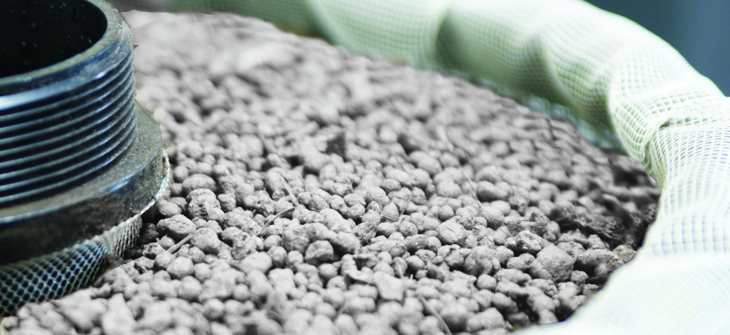
Six Filter Media Options to Meet Stormwater Treatment Regulations
Choosing the Right Filter Media for Stormwater Compliance: Six Proven Options
Stormwater regulations are calling for an increased level of treatment. Engineers often specify manufactured, media-based filtration systems to meet the most stringent stormwater treatment regulations.
Media filters work in two ways. First, stormwater passes over and through the media. Pollutants become trapped in the voids between media particles and on media particle surfaces themselves. The second way media filters remove pollutants from stormwater is through chemical reactions and adsorption. Adsorption occurs when a pollutant is removed through chemical or molecular actions.
Some media-based stormwater filtration system manufacturers offer different types of media, allowing engineers to design systems for site-specific pollutant removal. Different media types can be combined to target a wide spectrum of pollutants. Combining and using various media types allows the system to be easily adjusted to meet ever-changing site conditions and increasingly stringent regulatory requirements.
Knowing the available media options and their performance characteristics benefit engineers looking to utilize media filtration. Below are six types of filter media options available to use in Contech's Stormwater Management StormFilter to meet stormwater treatment regulations
Perlite is a natural volcanic ash, similar in composition to glass and similar in appearance to pumice. To use perlite as a filter medium, it must first go through a heating process to yield a lightweight, multicellular, expanded form. This expanded form has a coarse texture, very low-density, high surface area, and stable, inert chemistry, making perlite an excellent physical filtration medium. The multicellular nature of expanded perlite is the key to its excellent ability to trap sediments and adsorb oil. The coarse texture of the expanded perlite creates a bed of material with a very high porosity, which allows perlite to have the highest sediment and oil storage capacity of all available media options.
PhosphoSorb® is a lightweight media comprised of perlite and activated alumina. PhosphoSorb removes total phosphorus (TP) by absorbing dissolved phosphorus and filtering particulate-bound phosphorus simultaneously. The perlite removes suspended solids, while the activated alumina absorbs soluble phosphorus.
Zeolite defines a family of both natural and synthetic, hydrous aluminosilicate materials with a highly porous mineral matrix that holds light, alkali metal cations. Zeolite uses a cation exchange reaction that removes other cations from water, such as zinc, copper, lead, and ammonia. In the cation exchange reaction, the light metal cations in the zeolite matrix are displaced by the heavier metal cations, such as copper, in the water. Zeolite is an excellent option for removing metals when CSF media cannot be used.
CSF® Leaf Media is a patented filtration media composed of composted deciduous leaves. Contech purchases the mature, stable, deciduous leaf compost and then processes it into an odorless, pelletized compost product with physical and chemical characteristics desirable for stormwater filtration. The patented compost process creates a material with excellent flow-through characteristics and stability in water. Not only does CSF Leaf Media consist of 100% recycled, all-natural materials, but it also provides good removal of sediments and a wide range of toxic contaminants. Sediment and total nutrients are removed through physical filtration. Oil, complex metals, and anthropogenic organic contaminants such as herbicides and pesticides are removed through adsorption, the physical partitioning of organic compounds, such as pesticides, to carbon-rich materials, such as compost. Soluble metals are removed by cation exchange and complexation of metal ions to the organic chelating agents present in compost.
Granular Activated Carbon (GAC) is a widely accepted water filtration media that removes organic compounds. It consists of pure carbon (originating from coal or charcoal) whose micro-porous structure has been enhanced through steam or acid "activation." GAC's high carbon content and porous nature account for its excellent ability to remove organic compounds through adsorption. Since adsorption is the physical partitioning of organic compounds to high carbon surfaces, the "activation" of the carbon (which creates GAC) gives it an enormous surface area upon which adsorption can occur.
ZPG™ (Zeolite, Perlite, GAC blend)
This proprietary blend of zeolite, perlite, and granular activated carbon media provides an alternative for CSF media for installations where leaf media cannot be used.
